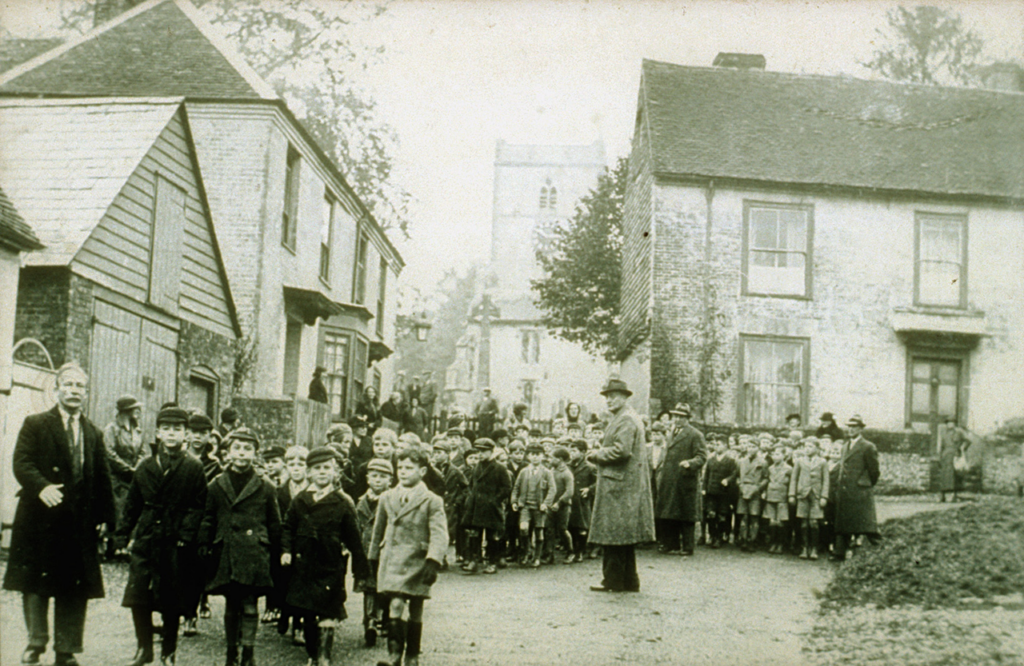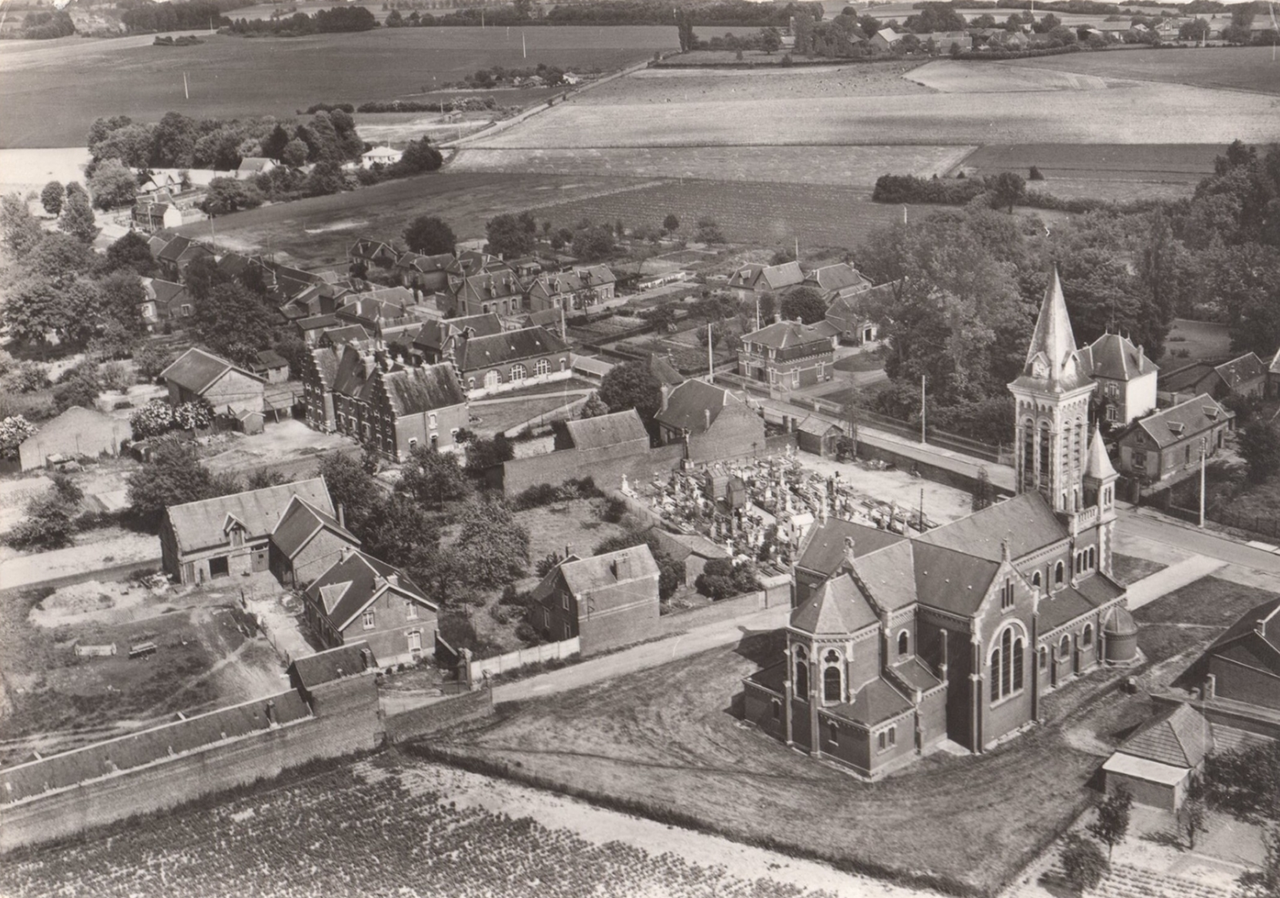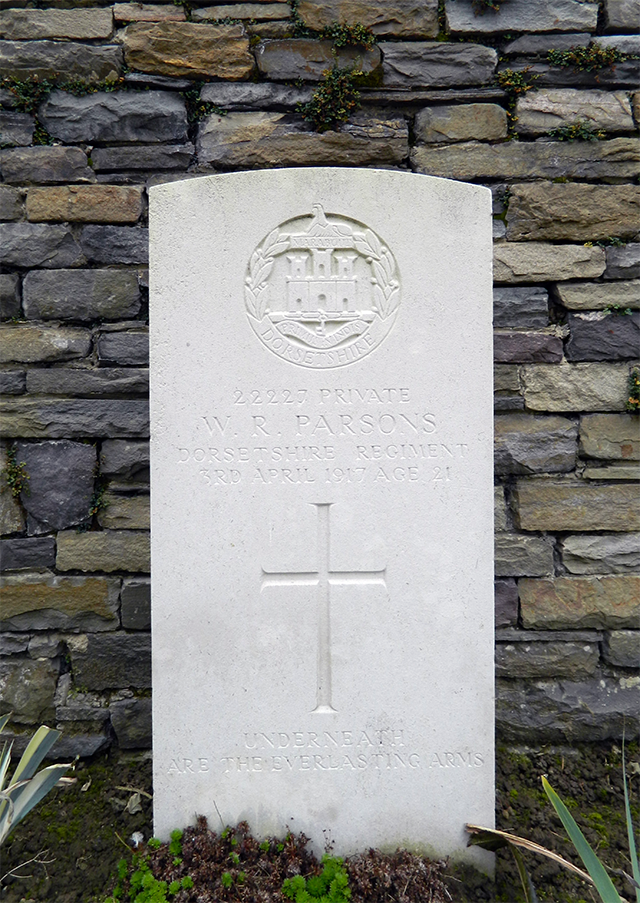Private William Richard Parsons, 22227 of B Company, 1st Battalion Dorsetshire Regiment, was killed in action at Holnon, France on 3rd April 1917.
Family Life
We start the family with William’s parents: Benjamin Richard and Emily (née King). We know little of Emily. She was born in 1866 at Woodlands St. Mary—a scattering of a few homes in the countryside near Lambourn, Berkshire, mid-way between Swindon and Newbury. The family is absent from the 1871 Census and by that of 1881 she had moved away from the parental home and is recorded as a domestic servant in Tottenham, London. 1891 sees her still in service but as a cook to a surgeon at 24 Saville Row, Westminster. She married Benjamin two years later, in Portsmouth. He was a merchant seaman, born in Itchenor, a small village on Selsey Bill, near Bognor Regis, Sussex, and was the son of a master mariner.

Benjamin and Emily had five children: four boys and a girl, all born in Portsmouth. In order, they are: William Richard (1895), Charles Gordon (1898), Ethel Miriam (1901), Henry Cecil (1903), and Ernest Alfred (1906). William’s extended family was large, with eight bloodline aunts and uncles on his father’s side.
By the time of the 1911 Census, the family are living in the Newtown area of Gosport. This is separated from Portsea Island (the main island of Portsmouth, where they had lived previously) by the mouth of Portsmouth harbour. Benjamin, as head of the household, is listed as ‘Mariner on Yacht’. All the children are simply recorded as ‘School’. William is 15 and if he were to become a Pupil-teacher, he would presumably have done so at the end of the 1910-1911 academic year, before turning 16.

We do not know for certain which school the children attended but for William and his brothers the only school within easy walking distance was Newtown Boys School, Joseph Street, with a capacity of 290 children and average attendance of 240.1 Frank Edward Gregory was the headmaster from 1900 to 1934. It cannot have been an entirely pleasant school for the staff as it was in a condemned, unsuitable building, with the monotonous clang of the anvil and the pungent smell of burning hoof from the smithy on the opposite side of the street.2 However, the latter observation is made from an adult’s perspective; often such distractions, sounds and smells are exciting diversions for a child and the stuff of potent and often happy memories.
It is likely that William would have attended a secondary school: the old route into the teaching profession through working as a pupil-teacher was being closed off as the old Monitorial System (or Lancastrian system as it was sometimes called) was superseded. In its place secondary education was preferred followed by a year as a student teacher before moving on to higher education. We do not know which school he attended. In order to gain entry into a teacher training college—a prerequisite to becoming a Certificated Teacher—he would have undertaken the Preliminary Examination for the Elementary School Teachers’ Certificate examinations. These comprised two parts: compulsory subjects in Part 1 needed to be passed before continuing onto Part 2. In the second part, there were compulsory subjects English, History and Geography, together with three electives from the following broad subject areas: Elementary Science, Elementary Mathematics, and Foreign Languages. At the age of eighteen, William, having passed his exams and secured his place, prepared to start student life at Winchester Training College.
Winchester Training College at Exeter, 1914-1916
Britain declared war on Germany at 7pm on the fourth of August, 1914. William’s expectations of study at Winchester were thrown in the air. The start of his first term at Winchester, less than one month off, was in doubt.
Those students already studying at the College and who were part of the College Territorial Company had immediately been mobilised for war and would not return to studies. This accounted for 74 students out of 80 (92.5%). Others would have enlisted in the Army later while a small number would have been medically exempt. As a result the college closed in the summer of 1914—the first training college to do so but other training colleges would follow. Eventually, by the start of the 1916–1917 academic year, only St. John’s College Battersea remained open. The disruption to training during the Great War was therefore considerable for new and continuing WTC students:
During the first year of the war six second-year students and four certificate (one-year) students were sent to Bede College, Durham. In 1915 the Principal was able to visit Durham where there were then 22 Winchester students. Also in 1914 24 first-year students were sent to the Exeter Diocesan Training College,3 and three members of staff went with them… No teaching took place in the college [Winchester Diocesan Training College] throughout the war.
Rose, M. A History of King Alfred’s College, Winchester 1840-1980

The College Student Register for September 1914 is headed, ‘The College being closed these men spent their First Year in the Exeter Training College and their Second Year in the York Training College.’ There follows the list of the new students, including William. All of these were still Winchester Training College students and under the care of the College staff. By the start of the 1915 academic year, Exeter had closed and remaining students were transferred to Bede College, Durham. Had not military service intervened, William would have begun his second year there under the same arrangements, still as a Winchester student. These receiving colleges evidently proved a welcoming to their exiled Winchester students. If Exeter welcomed other colleges’ students in the same way as Bede, then our Wintonians would seem to have been made most welcome. The college magazine, The Bede (the parallel publication to WTC’s The Wintonian), carries this reference to its sojourners, from a Senior (second year) Bedeite student’s view:
It must have been very hard for them to leave their own college with its pleasant memories and associations, but we hope they will look back upon their year at ‘Bede’ as one of the happiest spots of their lives.
Our Juniors, drawn from Peterborough and Winchester as well as those who in the ordinary course would have entered ‘Bede,’ were to be taught to look upon ‘Bede’ and all appertaining to it with the reverent awe due to such sacred things. We entered into this work most assiduously. Theirs was the pleasure of being initiated, and they assure us they fully appreciated the delicate manner in which we communicated to them the knowledge that they were Bedeites. We sincerely hope they will maintain the traditions and customs which form one of the pleasantest sides of College life and are only to be found in the old Colleges for here they have been jealously guarded for years.
The Bede, Vol.12 No.3, June 1916
There is a more detailed section on the closure of WTC, other colleges and the transfer of students during the war in the biography of Frederick William Randolph.
The Winchester buildings during this time were used by the army. In the early months of the War, the College Company was billeted there, followed by various Battalions, through to November 1915. Thereafter the Army Pay Department occupied all of the buildings apart from the Principal’s Lodge, the Library and the Chapel. Because of this disturbance of College life, the student publication, The Wintonian, ceased to be published and therefore we have no window on William’s life at Exeter. There was a special War Supplement published in 1916 which mainly carried details of students in military service. It lists William amongst the 1916 leavers4 as simply ‘Pte., 3rd Hants Battalion, Portsmouth’. Brief as this is, it is welcome piece of information.
William’s War
We are hampered in tracking his Army service by the absence of his Soldier’s Records. It is quite usual for a soldier’s main bundle of papers to be missing: most were destroyed in the Second World War when an enemy incendiary device landed on the storage warehouse during the Blitz. However, ledgers and indexes existed elsewhere, which often helps reconstruction. His entry in a Soldiers’ Effects ledger tells us that on his death his mother, as next of kin, was due a War Gratuity payment of £5 0s. This amount is related to his length of service and is commensurate with an enlistment date sometime in the month following 4th December 1915. His Hampshire Regimental Number (21869) further narrows this to December 4th to 13th as the numbers were issued in series and soldiers with close numbers and known enlistment dates give us the approximate range of dates.
As already stated, William enlisted in the 3rd Battalion Royal Hampshire Regiment. This was not a front-line unit but a Reserve Battalion. The men were held in England (the college record has him in Portsmouth in June 1916) where they were trained and then dispersed to strengthen depleted front-line Battalions as needed. It is therefore no surprise to find that William is listed as having been active in a second Battalion: 1st Battalion Dorsetshire Regiment (Regimental Number 22227). .
We have no direct evidence of when this transfer took place but again his new Regimental Number is helpful. Some records survive of other men with proximal numbers (22207, 22230 and 22252) and these were all 3rd Hants soldiers who had been transferred to 1st Dorsets. All records tell the same story: the men (still in 3rd Hants) embarked at Southampton on 1st July and the following day were in 3rd Infantry Base Depot—a holding and further-training camp for reserves, near Rouen. All these other men’s Army files then record that on 15th July they received orders that they would join their new unit ‘In the field’ and carry the same words: ‘1st Dorsets. Joined Battalion, 17.7.16.’ Additionally, the 1st Dorsets War Diary for that date tells us:
Place: Halloy & Brevillers
Date: July 17 1916
Battalion marched from Senlis to billets in Halloy arriving latter place 3.50pm. Re-inforcement of 294 Other Ranks joined.
The new recruits joined the Battalion—part of the 14th Brigade in the 32nd Division—after its part in the major offensive of the Battle of Albert on the Somme. Total British casualties from this action were some of the worst of the war. The six Divisions (approximately 100,000 men) numbered 82,500 killed, missing or injured, with about 50,000 of these accounted for on the opening day of the offensive on 1st July. The battalion had been active in this particularly in the Authuille Wood/Thiepval area. The Battalion War Diary is meticulous in including a ‘Field State’ record giving their fighting strength. It is sobering to note that before the Battle of Albert on 29th June they were at full strength with 1220 men. One week later on 6th July they had been reduce to 708, a 42% casualty rate. William was one of those brought in to replace the losses. By 27th July the unit was back up to 962 men.
Through the next months we see the activities of the 1st Dorsets in a chaotic list of place names. The men saw front line duties and actions at all of these locations. Billets and training locations are not included in the lists.
- October to November 15th: (return to the Somme) Albert, Bouzincourt and Mailly-Maillet
- Late August and September: north to Cuinchy, Le Quesnoy, Béthune, Cambrin, Ecoivres and Annequin
- December: (training/re-equipping)
- January: (Somme) Bertrancourt, Mailly-Maillet
- February to March: Mailly-Mailler, Le Quesnel, Rouy-le-Petit
- April 2nd: Holnon
Simply put, the battalion moved between (mainly) the Somme and an area of northern France near the Flanders border (Béthune/Lens/La Bassée area). We hear much of places such as Ypres in Flanders and the Somme in France, but this northern area was a strategic bridge between the two major conflicts and needed to be well defended. While not having the dubious cachet of the set-piece battles of the Somme and the Ypres Salient, there was nevertheless significant constant conflict and it held horrors of its own. Life there was loathed by the men who ground out the conflict week in, week out, and may be familiar to those who have read Robert Graves autobiography Goodbye To All That. Graves had been stationed in Cuinchy for some time and hated it:
Cuinchy bred rats. They came up from the canal, fed on the plentiful corpses, and multiplied exceedingly. While I stayed here with the Welsh, a new officer joined the company… When he turned in that night, he heard a scuffling, shone his torch on the bed, and found two rats on his blanket tussling for the possession of a severed hand.
Robert Graves

An attack to take possession of the village of Holnon, 6 kilometres west of St Quentin. This was launched at 5am on 2nd April and, by 6am, the objective of taking the village had been achieved with minimal losses: 1 Officer wounded, Other Ranks: 1 killed and 14 wounded. The Battalion was then tasked the next day with consolidating their position. The extract from the diary records that during this work they lost one Officer and one Other Rank (i.e. NCO or Private)—William had been killed in action.5 William fell with Second Lieutenant Stanley Wolferstan of Hordle, Hampshire, who was 19 years old.


His body lies buried at Chapele British Cemetery, Holnon, Departement de l’Aisne, Picardie, France.
Researcher and Author: John Vickers
Sources
For all general Winchester Training College records please see the list of University of Winchester sources at the end of the following Sources list.
Ancestry (2018). Home page. [online] Available at: www.ancestry.co.uk [Accessed 2018].
Civil, G. (2009). Christ Church, Gosport, A History. [PDF] Gosport: Kemp Brothers and Wootton, Ltd. Available at: http://www.christchurchgosport.co.
uk/wp-content/uploads/2012/10/
christ_church_history.pdf 1/3/2018 [Accessed 2018].
Commonwealth War Graves Commission, (2018). Home page. [online] Available at www.cwgc.org/ [Accessed 2018].
Erger.co.uk (2018). Ships in portsmouth Harbour, Gosport, around 1890. [online] Available at: http://www.erger.org.uk/pics/
Ships1.jpg [Accessed 2 March 2018].
Gosport Society (2018) Newtown Boys School. [online] Available at: https://www.gosportsociety.co.uk/
Batch%204%20117.jpg [Accessed 2 March 2018].
The Keep Military Museum (2018). The 1st Battalion The Dorsetshire Regiment in World War One. [online] Available at: http://www.keepmilitarymuseum.org/
history/first+world+war/the+dorsetshire+
regiment/the+first+battalion [Accessed 2018].
Kelly’s Directory (1911). Kelly’s Directory of Hampshire, Wiltshire, Dorsetshire, The Isle of Wight and The Channel Islands, 1911. [online] Available at: http://specialcollections.le.ac.uk/
cdm/landingpage/collection/
p16445coll4 [Accessed 2018].
National Union of Teachers. (1920). War Record 1914–1919. A Short Account of Duty and Work Accomplished During the War. London: NUT.
Rose, M. (1981). A history of King Alfred’s College, Winchester 1840-1980. London: Phillimore.
Vickers, J. University of Winchester Chapel Memorial Rail image.
Wikimedia (2014). File:The Exeter Diocesan Training College. Wood engraving by W.E. Wellcome V0012649.jpg [online] Available at: https://commons.wikimedia.org/wiki/
File:The_Exeter_Diocesan_Training_College._
Wood_engraving_by_W.E._Wellcome_
V0012649.jpg [Accessed 2 March 2018].
University of Winchester Archive at Hampshire Record Office
All the following documents are general background resources for the WTC Fallen project and provide general period background of students, college life, staff, activities, etc. The Finding Numbers are given to aid archive searches.
47M91W/P2/4 The Wintonian 1899-1900
47M91W/P2/5 The Wintonian 1901-1902
47M91W/P2/6 The Wintonian 1903-1904
47M91W/P2/7 The Wintonian 1904-1906
47M91W/P2/8 The Wintonian 1905-1907
47M91W/P2/10 The Wintonian 1908-1910
47M91W/P2/11 The Wintonian 1910-1914
47M91W/P2/12 The Wintonian 1920-1925
47M91W/D1/2 The Student Register
47M91W/S5/5/10 Photograph of 5 alumni in Mesopotamia
47M91W/Q3/6 A Khaki Diary
47M91W/B1/2 Reports of Training College 1913-1914
47M91W/Q1/5 Report and Balance Sheets 1904- 1949
47M91W/R2/5 History of the Volunteers Company 1910
47M91W/L1/2 College Rules 1920
55M81W/PJ1 Managers’ Minute Book 1876-1903
71M88W/6 List of Prisoners at Kut
All material referenced as 47M91W/ is the copyright of The University of Winchester. Permission to reproduce photographs and other material for this narrative has been agreed by the University and Hampshire Record Office.
- Kelly’s Directory of Hampshire, Wiltshire, Dorsetshire, The Isle of Wight and The Channel Islands, 1911
- Christ Church, Gosport, A History
- Founded 1839 in Cathedral Close, Exeter. Moving to Heavitree Road in 1854 it became known as St. Luke’s College it was eventually incorporated into Exeter University in 1978.
- 1916 here refers to the expected year of completion of study, not actual. The Supplement is dated June 1916, which is before the end of the 1916 academic year. There are students listed still in their leaving-year group who had enlisted part-way through their course.
- The Dorsets’ account is no different from other battalion diaries: the death or wounding of Commissioned officers was often recorded by name. Non-Commissioned Officers and Privates were rarely accorded such honour.
